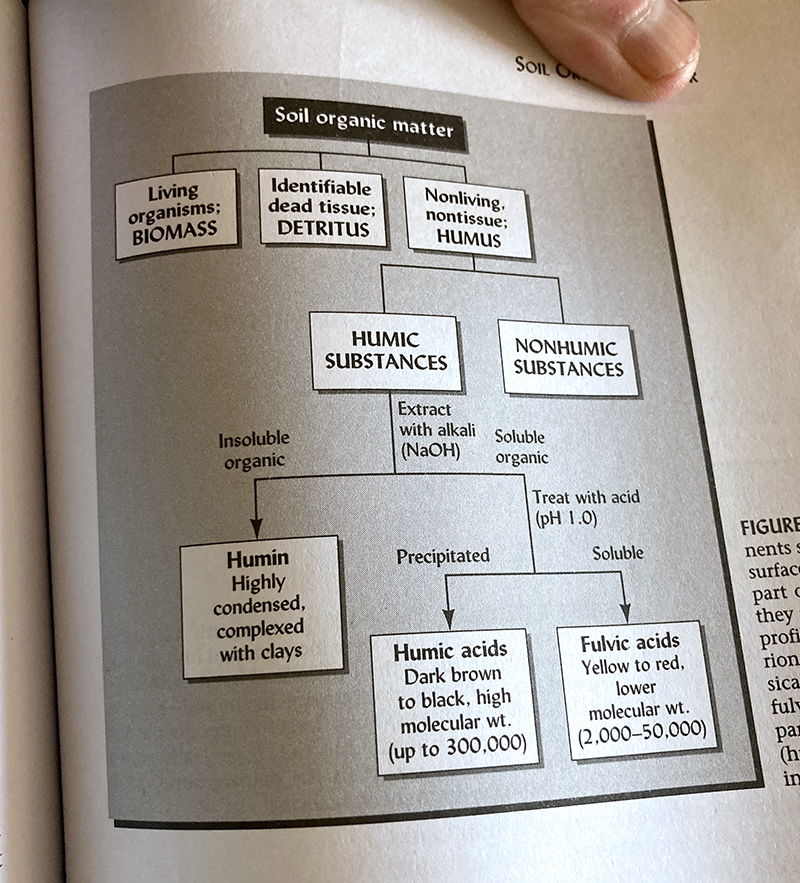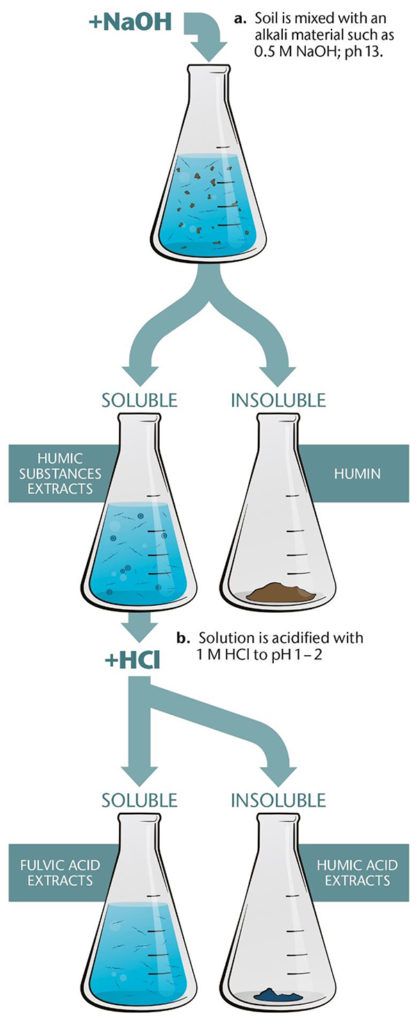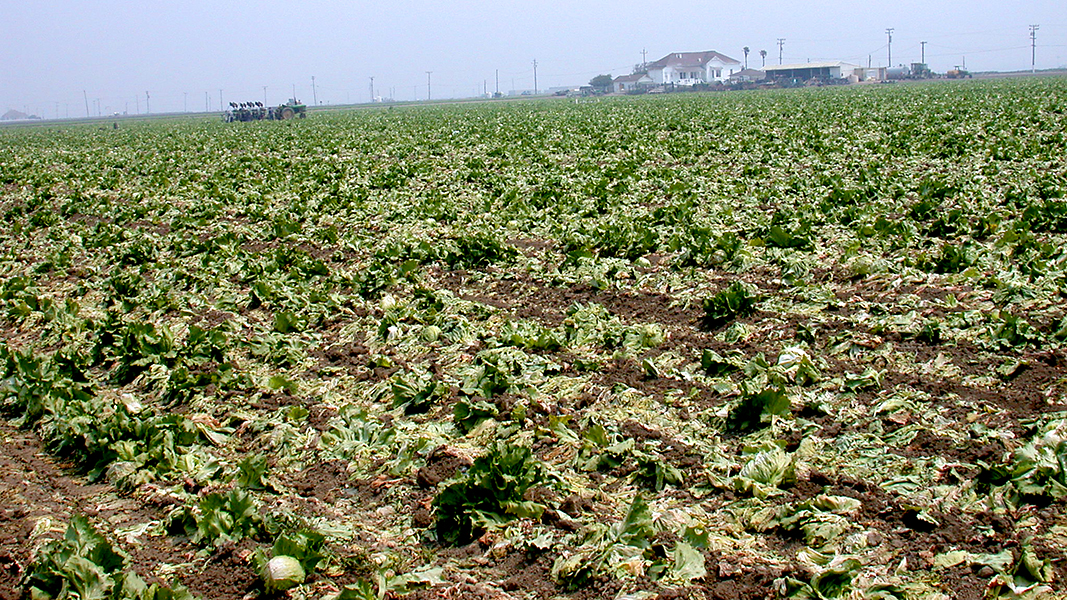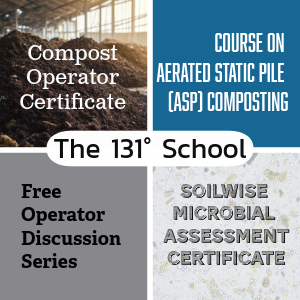Top: High intensity agriculture would benefit from a 3-course meal: compost, crop residues and cover crops. Photo by Sally Brown
 Sally Brown
Sally Brown
Did you learn about humic and fulvic acid in your Soils 101 class? I certainly did (Figure 1). Those two categories of compounds were the key to longevity in soil organic matter (SOM). Through microbial decomposition and various types of not fully understood chemical transformations, the organic compounds that we recognize (carbs, fats, and proteins for example) got transformed into these amazingly complex giants that stayed put in soils for thousands of years. Think of them as the traditional soil science equivalent to biochar. Too big and too complex to eat, these formed the backbone of stable organic matter in soils. We quantified them by complex extractions — adding different chemicals to soil to get them to come into solution and be measured (Figure 2).

Figure 1. “Classic” Soils 101 class textbook. Photo from Nature and Property of Soils. Ray R Weil and Niles C Brady (13th Edition, 2001).
Well, it turns out that they (humic and fulvic acids) really don’t exist. In the last 20 years or so we have replaced complex extractions with complex cameras. We are increasingly able to take pictures of soil in situ at very high magnification. And those pictures have told us that while humic and fulvic acids may be the organic forms of legend, the reality is a different story. This revolution in our understanding of SOM got headlines recently in an article in Quanta Magazine (Popkin, 2021). The article is titled “A Soil-Science revolution upends plans to fight climate change,” and the author argued that because these long-lived compounds are a laboratory artifact rather than a reality, soil carbon storage is not going to be the answer for climate change.
What Changed?
What are these big changes in our understanding? Well instead of fulvic and humic acids, we now have free particulate organic matter (POM) and mineral associated organic matter (MAOM) (Dynarski et al., 2020). I have to confess I am not convinced that either term sounds better. The point is not how they roll off the tongue but how they work in soil. POM is out there floating around. It is ready to be eaten but also ready to migrate down in the soil profile where very few bugs hang around. Once down below the root zone this POM — however big or small the particles are — are pretty well protected from microbial decomposition.

Figure 2. Extraction of organic matter with alkaline and acid solutions. Source: Collins et al, 2019, WSU Extension
You may remember the recent study that came out of the University of California, Davis (Tautges et al., 2019). In that study the authors looked at carbon storage by depth in cover crop and compost amended soils. While the cover crops make the soils richer at the surface, they seem to rob the carbon from down below. Now people are thinking that perhaps having an excess of POM that moves through the soil is a way to prevent that loss of organic matter.

Figure 3. Amount of soil organic matter associated with minerals or as free particulate organic matter with increasing carbon inputs (Collins and McGuire, 2019, adapted from Castellano et al. 2015). Source: WSU Extension
The MAOM is organic matter that is glued to a mineral (Figure 3). Here different types of clays that have enormous surface areas can provide a virtual hiding place for the organics. Stuck in a clay nook, the MAOM is hard to find and hard to eat. Once it gets unstuck, however, it is effectively on the buffet. Getting unglued can happen via a range of factors including a lot of water or a change in the chemical bond or glue that created the bond in the first place. Along with these new particle classifications, there are a range of new extractions to quantify whether your SOM is tempting to the microbe or more likely to persist. Permanganate oxidizable labile carbon or POX-C, for example, measures carbon that is around to be eaten.
What Does It Mean?
What this new understanding tells us is something that we are increasingly recognizing as critically important: soils are alive. The more carbon cycling that goes on in soil systems, the healthier those systems are. Increasing soil carbon stocks while simultaneously keeping soils healthy means adding living, cyclable carbon into the soils. It means feeding the soils because they have to be fed.
Soils in natural systems can take care of feeding themselves. Look at the tall grass prairie before the Sod-busters arrived. The grasses had as much growth below ground as above, all food for a wide range of animals and organisms. The animals that grazed on the grasses left their feces and corpses around to further feed the soils. These soils grew their own food. When they were converted to wheat, corn and soybeans the balance was disrupted. In addition to the plow, now farmers were removing the stuff that the soil had so kindly grown and taking it to far off places.
In cities and feedlots, that food and feces have mostly not gone back to the fields. The whole notion of agriculture is taking what the soil has grown away to be used/eaten elsewhere. This practice also lessens the soils’ ability to feed itself. In order to keep these same soils healthy and productive, we are starting to understand that we have to feed them. In cases where we use the soil to grow stuff that is taken away (aka harvested), we have to bring some of those residuals back.
What it means is that in order to maintain soil health, and soil carbon storage, we have to let soils spend some time growing their own food (cover crops) and/or bring back the leftovers. I am not talking about natural systems here where soils are left to grow their own. I am talking about agricultural systems or commercial forestry where much of the biomass that is produced is removed.
A Three-Course Meal
We are now learning how to best feed soils. It seems that for extreme cases, a multi-pronged approach may be necessary. Think of it as a three-course meal: compost, crop residues and cover crops. A study out of California looked at soil carbon in vegetable production (White et al., 2020). Here soils are tilled, tilled again and molded into rows. Two crops are grown and taken away each year. Not the best for keeping soil healthy. The researchers integrated cover cropping into this rotation either once a year or once every four years. They also added yard trimmings compost. All residues were left on site. They found that the cover crops fed the soil microbes and helped the plants get bigger. Compost was the big winner for soil carbon storage. Putting the two together got you bigger plants and higher carbon storage. If you want a soil to work that hard for you, you really have to feed it often and well.
This fuller understanding of how SOM operates in no way takes away the importance of soils as a tool for carbon storage. Rather it suggests that policies based on burying and coming back decades later to retrieve carbon are flawed. Science now understands the importance of active carbon and the carbon cycling that goes along with it. That knowledge has to transfer to policies that focus on soil stewardship and carbon storage. By doing so the soils can stay well fed and so can the planet.
Sally Brown, BioCycle’s Senior Adviser, is a Research Professor in the College of the Environment at the University of Washington.













